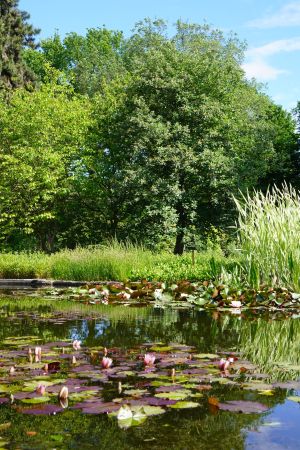The Botanical Garden of Adam Mickiewicz University, Poznań, and the Dendrological Garden of Poznań University of Life Sciences are jointly celebrating their 100th anniversary. To mark the occasion, they hosted a conference and Convention of Botanical Gardens and Arboreta in Poland: "The future of botanical gardens: adaptation and education in the face of climate change". Experts, scientists and practitioners from the areas of botany, horticulture, ecology, environmental protection and education gathered in Poznan.
- "The last few months, in fact even years of cooperation, have strengthened our mutual relations between the gardens considerably", said Professor Justyna Wiland-Szymańska, Director of the AMU Botanical Garden. - "Many employees of the Dendrological Garden have come out of our Garden. It has been a long tradition. We also feel that we are, in a way, a breeding ground for talent. It is particularly meaningful that we can support each other, as the Dendrological Garden adopt a slightly different approach because it is known that diversity is the most crucial thing. There are various collections a different ways of managing these collections, but this is what makes us perfectly complementary, in a manner of speaking, sitting on two sides of the Seganka River," added Prof. Justyna Wiland-Szymańska, expressing her gratitude for the many congratulations from guests who came to celebrate the 100th anniversary.
The Botanical Garden in Poznań protects an area of approximately 22 hectares, with approximately 6,000 collected taxa arranged in 10 thematic sections. It is a university-wide unit protected by the Nature Conservation Act of 16 April 2004. The park section has also been protected as a monument of the City of Poznan since 1975. Nature education classes in horticulture, botany and zoology are conducted there. Outdoor and indoor exhibitions of nature and art are presented. Scientific and cultural meetings, such as the “Literary Bench”, are held here. The Garden is visited by about 150,000 visitors a year and is open to the public free of charge, offering a place of respite amidst the greenery throughout the seasons.
The Poznań Botanical Garden was created at the time of the resurgence of the Polish state for the benefit of secondary and general schools. The School Botanical Garden (1922-1925) was established directly by Dr Joachim Namysł, Władysław Marciniec and Professor Rudolf Boettner, who was its first director. The Garden was administratively subordinate to the Magistrate and the School Board of the Poznan School District. Scientific supervision, on the other hand, was exercised at all times by professors from the University of Poznan.
An extensive Department of Plant Systematics with a basin for aquatic plants, ecological departments and a wooden didactic pavilion were created on an area of approximately 2.5 hectares. From 1928, the Garden was managed by the State Horticultural School, headed by Wacław Zembal, M.Sc. In 1930, the Garden was enlarged by a further 9 ha, on which an extensive Department of Plant Geography and ornamental plant quarters were created according to a design by Professor Edward Straus.
The period of occupation marked a stagnation for the Garden regarding the development of the collection. After the war, the Garden continued to be managed by the P.S.O. In 1949, as a result of reorganisation, the Garden was absorbed by the University of Poznań. It became one of the units of the Department of Plant Systematics and Geography of the Faculty of Mathematics and Natural Sciences. With its rich collections, it provided an excellent base for teaching. The Alpinarium was expanded, with the construction of the building designed by Z. Hellwig starting as early as 1938. The Garden's staff conducted classes and student internships and supervised master's theses.
